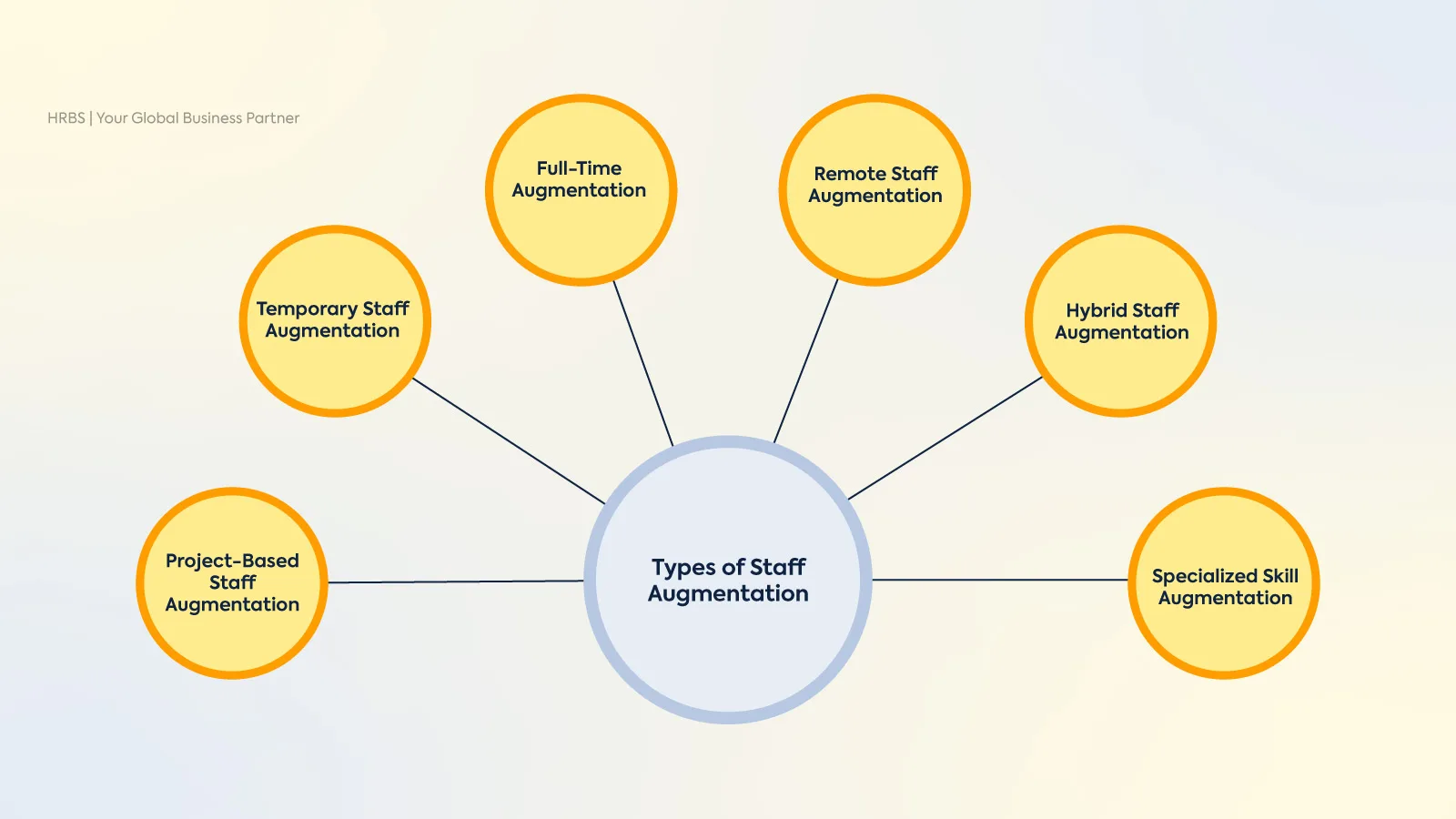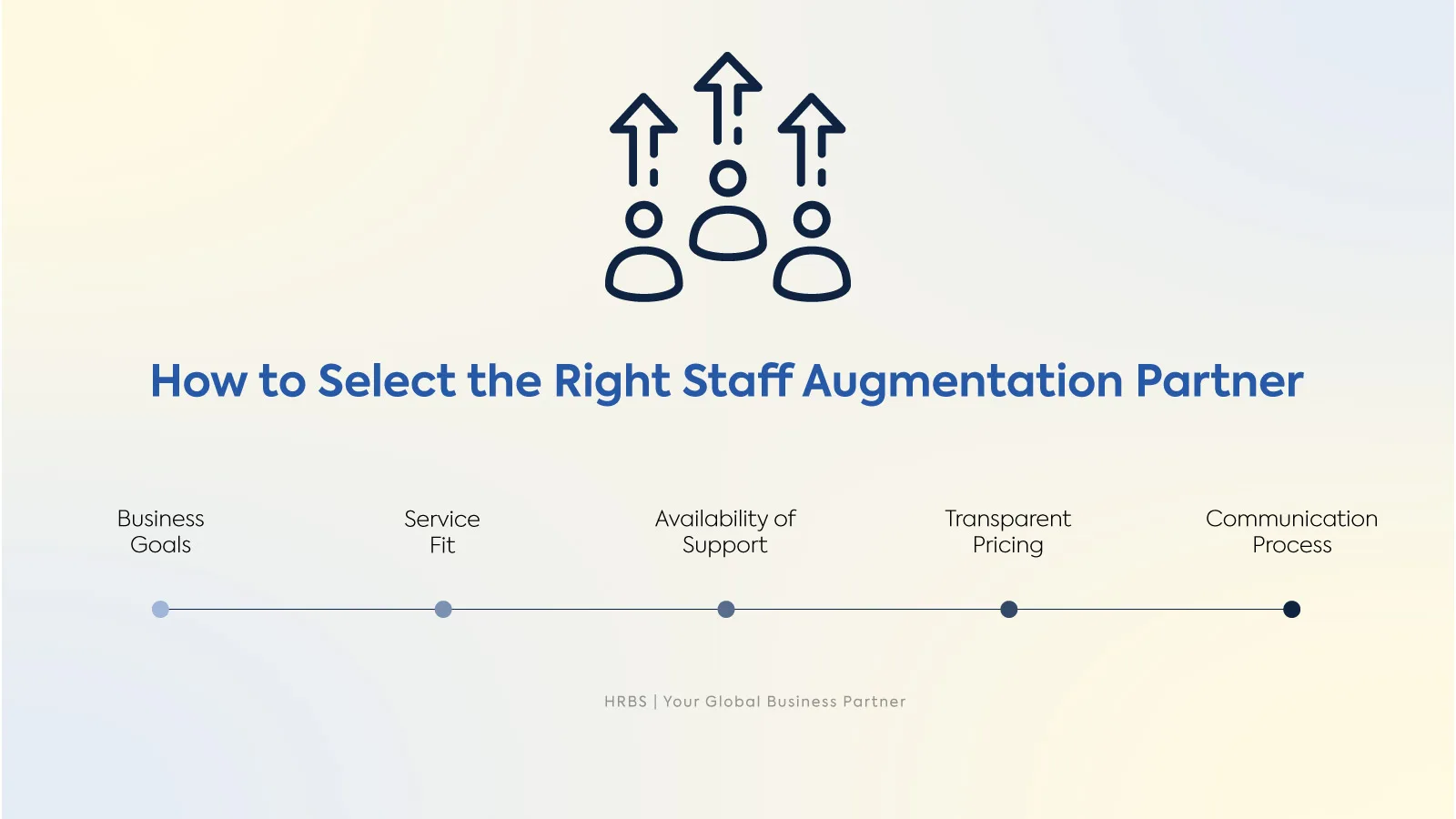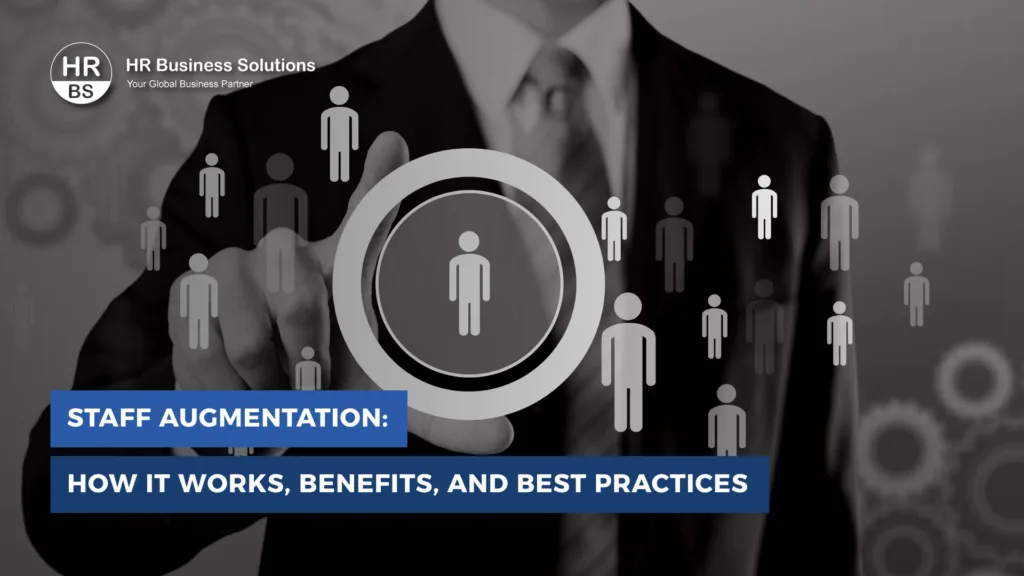If you’ve been dealing with long hiring cycles, difficulty finding the right skills, or managing extra project work, you know how challenging growing your team can be. Staff augmentation helps you add skilled professionals to your existing team on a temporary basis, so you can meet deadlines and fill skill gaps without the wait or cost of full-time hiring. Unlike outsourcing, staff augmentation means these professionals work directly under your management, allowing you to keep full control of your projects and team. This approach suits businesses that need the flexibility to quickly grow their workforce without long-term commitments.
In this guide, you’ll find clear insights on how staff augmentation works, the benefits it brings, common situations where it helps, and how it compares to other hiring methods. We’ll also cover challenges to watch for and best practices to help you get the most value from this staffing method.
What is Staff Augmentation?
Staff augmentation is a flexible hiring approach where a company temporarily adds skilled professionals to its existing team to fill skill gaps, meet project deadlines, or handle increased workloads. Unlike full outsourcing, these professionals work under the company’s direct management, giving the business full control over projects while accessing specialized skills without long-term commitments.
This model allows businesses to quickly expand their workforce, reduce hiring costs, and respond quickly to changing project needs. By combining external experts with in-house teams, companies maintain continuity, protect company culture, and improve collaboration.

Types of Staff Augmentation
Staff augmentation offers different ways for companies to bring in external professionals based on their specific requirements. Choosing the right type helps meet project demands efficiently without permanent hiring. Here are the main types of staff augmentation:
- Project-Based Staff Augmentation: Professionals are hired specifically for the duration of a particular project. This type is ideal when specialized skills are needed to complete defined tasks within a set timeframe. It allows businesses to scale their teams with experts only as long as the project requires.
- Temporary Staff Augmentation: This model involves hiring professionals for a short period to handle immediate workload spikes, seasonal demands, or specific assignments. It helps companies manage fluctuating workloads without long-term commitments.
- Full-Time Augmentation: Hiring full-time professionals on a temporary basis to work onsite or remotely as part of the team. This works well when a business needs dedicated resources for extended periods but still wants to avoid permanent hiring.
- Remote Staff Augmentation: Skilled experts work from remote locations, often through a third-party provider or freelancing platforms. This type broadens access to talent globally, offering cost-effective and fast scalability without geographical constraints.
- Hybrid Staff Augmentation: A combination of different augmentation models, such as mixing onsite and remote workers, or combining project-based and FTE resources. This model provides flexibility and tailored solutions to complex workforce needs.
- Specialized Skill Augmentation: Hiring professionals with highly specific expertise in niche areas like cybersecurity, artificial intelligence, or cloud computing. This model focuses on quality and targeted capability for critical roles.
Each type of staff augmentation offers distinct advantages, and companies often select based on project size, urgency, budget, and technical requirements. Choosing the right model ensures optimal team performance, cost efficiency, and alignment with business goals.
How Staff Augmentation Works
Staff augmentation is a simple and effective process that helps companies add skilled professionals to their existing teams to meet project needs without full-time hiring. Here’s how it typically works:
- Identifying Needs and Skill Gaps: The process begins with a detailed analysis of the existing team’s capabilities and current project demands. Companies examine where skills or resources are missing that could impact project success. This step also involves forecasting upcoming projects and potential challenges to determine which expertise is required, down to specific roles and technologies.
- Defining Clear Requirements: Once gaps are identified, companies must precisely define the requirements including job descriptions, technical skills, experience levels, expected duration, and performance indicators. Clear, detailed requirements reduce misalignment and ensure providers source the right candidates.
- Choosing a Reliable Partner or Provider: Most companies collaborate with trusted staff augmentation providers that maintain a pool of pre-vetted professionals. Selecting the right partner involves evaluating their industry knowledge, recruitment process, communication style, and ability to quickly provide suitable resources. Companies should prioritize providers who understand their business goals and culture.
- Screening and Selecting Candidates: Providers present profiles of potential professionals who match the job criteria. Companies review resumes, portfolios, and conduct interviews to assess both technical skills and cultural fit. This two-way selection process ensures seamless collaboration and high productivity.
- Onboarding and Orientation: Effective onboarding is critical for fast integration. New professionals receive access to company systems, project documentation, and participate in team meetings. Clear communication about roles, workflows, and company values fosters alignment and empowers augmented staff to contribute quickly.
By following this clear process, companies can quickly fill critical skill gaps, keep projects on track, and maintain control over outcomes, all while managing budgets effectively.
Benefits of Staff Augmentation
Working with a staff augmentation provider brings clear advantages to both your team and your business. Here are some key benefits you can expect:
- Cost Savings: Staff augmentation reduces expenses linked to full-time employees such as benefits, training, and office space. Businesses pay only for the services they need, helping them manage budgets better and reduce overhead costs.
- Quick Access to Skills: This model allows companies to bring in professionals with the required skills quickly, avoiding delays caused by lengthy recruitment processes.
- Flexibility: Companies can increase or reduce the number of team members based on current workload and project needs, preventing both staff shortages and unnecessary labor costs.
- Management Control: Unlike outsourcing whole projects, staff augmentation keeps control within the company. Managers oversee the augmented team members directly, ensuring quality and deadlines are met.
- Access to Specialized Expertise: Staff augmentation provides access to professionals possessing specific skills that may not exist within the current team, which improves project quality and fills gaps efficiently.
- Lower Hiring Risks: Temporary staffing limits risks by avoiding long-term commitments, especially when project needs or business conditions might change unexpectedly.
- Faster Project Completion: Hiring skilled professionals who can start immediately helps speed up project delivery and meets tight deadlines without compromising quality.
Cost and Pricing Structure of Staff Augmentation
Staff augmentation pricing varies depending on business needs, project scope, and resource requirements. Understanding common pricing models helps companies budget effectively and choose the best option. Here are the main cost structures used in staff augmentation services:
- Hourly Rate: Charges are based on actual hours worked by the staff. This model offers flexibility for projects with changing requirements or unpredictable workloads. Companies pay only for the time used, making it suitable for short-term or variable work. Rates vary by skill level and location.
- Monthly Charges: A fixed monthly fee is paid for ongoing, dedicated access to staff. This arrangement suits long-term projects where consistent support is needed. It helps businesses forecast costs and maintain a stable team without full-time hiring commitments.
- Project-Based Pricing: Costs are determined by the entire scope of a defined project. This model provides budget certainty and shifts the risk of time overruns to the provider. It works best when project deliverables and timelines are clearly specified.
- Subscription-Based Pricing: Clients pay a recurring fee for access to a defined level of staffing services. This is common for businesses needing ongoing support but not full-time employees.
- Additional Costs: Some providers may charge extra for onboarding, training, or tools needed by the staff. It’s important to clarify all potential fees upfront to avoid surprises.
Staff Augmentation vs. Other Hiring Models
| Aspect | Staff Augmentation | Outsourcing | Full-time Hiring |
| Control Over Team | Direct management and oversight of augmented staff, integrated within internal teams. | Limited control as work is managed by the service provider with minimal direct oversight. | Full control and long-term commitment to employees. |
| Cost Flexibility | Moderate cost with pay-as-you-go model, no long-term benefits or severance costs. | Often lower upfront costs due to fixed contracts but can have hidden fees or scope limitations. | Higher fixed costs including salaries, benefits, training, and overhead. |
| Access to Skills | On-demand access to specific, specialized skills quickly sourced to meet immediate needs. | Access limited to provider’s available resources and expertise within contracted scope. | Access depends on internal recruitment capability; slower to acquire niche skills. |
| Scalability & Agility | Highly scalable and flexible; teams can be ramped up or down rapidly based on project demands. | Typically, less flexible; contracts define fixed scope and resources. | Scalability is slower and depends on lengthy hiring and onboarding processes. |
| Ownership of Work Output | The company owns all work and intellectual property, with direct staff integration and collaboration. | Intellectual property rights depend on contract terms; often owned by the provider. | Full ownership and responsibility for work outcomes and IP. |
| Risk Management | Lower risk as contracts are flexible and the workforce can be adjusted without long-term liability. | Potential higher risk due to dependency on third-party providers and fixed contract terms. | Higher risk due to long-term employment commitments and associated costs. |
| Cultural Fit | Augmented staff can be integrated into existing culture and workflows. | Cultural alignment may be limited due to external team dynamics. | Strong internal cultural fit through dedicated employment. |
Challenges and Risks of Staff Augmentation
While staff augmentation brings flexibility and access to skilled professionals, businesses face specific challenges that need careful attention:
- Integration Issues: Integrating external staff into established teams can cause cultural misalignment, differences in work styles, and collaboration, impacting overall team productivity.
- Remote Management Complexity: Augmented workers often operate remotely or across time zones, making real-time communication, supervision, and performance tracking more difficult.
- Communication and Productivity Risks: Maintaining clear, ongoing communication is essential to ensure augmented staff align with company goals, meet deadlines, and avoid duplicated effort or misunderstandings.
- Compliance and Legal Issues: Navigating labor laws, contract terms, intellectual property rights, and confidentiality agreements requires careful legal oversight to avoid risks.
- Dependency Risk: Over-reliance on augmented resources without proper knowledge transfer can create gaps if key external staff leave suddenly.
Best Practices for Successful Staff Augmentation
To maximize the value of staff augmentation, follow these proven practices:
-
- Define Clear Scope and Roles: Specify the exact tasks each team member will handle along with deadlines and expected outcomes to ensure everyone understands their responsibilities and delivers on time.
- Establish Regular Communication: Use collaboration tools and schedule regular meetings to ensure smooth information flow between internal and augmented staff.
- Partner with Trusted Vendors: Select partners who consistently provide professionals experienced in your industry and open to quick adjustments. This reduces downtime and ensures smooth progress on tasks.
- Monitor Performance Consistently: Regularly evaluate progress with measurable KPIs and provide timely feedback for improvement.
- Plan Knowledge Transfer: Make sure augmented staff keep detailed records of their work and hold transfer sessions to share insights with your core team. This prevents loss of critical information when contracts end.
- Encourage Open Feedback: Promote an environment where team members can raise concerns or suggestions without hesitation. Timely feedback improves team morale, uncovers hidden issues, and promotes collaboration.

How to Select the Right Staff Augmentation Partner
Choosing the right partner for staff augmentation can shape the success of your projects and team dynamics. To prioritize what matters most, consider these factors:
- Business Goals: Understand what your team needs to achieve with staff augmentation. Whether it’s to fill skill gaps, meet deadlines, or scale quickly, clear goals help find a partner who matches those needs.
- Service Fit: Check if the partner offers services that suit your requirements. This includes access to professionals with the right skills, support for short or long-term engagements, and ability to adjust resources as demand changes.
- Availability of Support: Ensure the partner provides timely support. Whether it’s onboarding, problem resolution, or ongoing management, quick access to assistance saves downtime and improves productivity.
- Transparent Pricing: Look for clear, upfront information about costs. Understanding billing methods, possible extra charges, and contract flexibility helps avoid surprises and keeps budgets on track.
- Communication Process: Ask how often you will receive updates and progress reports. Regular, clear communication prevents misalignment and helps address issues before they arise.
Future Trends in Staff Augmentation
The staff augmentation industry is evolving rapidly as technology advances and business needs shift.These trends are helping companies fill critical gaps quickly while keeping costs under control and adapting to market demands efficiently.
- AI and Automation: AI tools are increasingly used to speed up the recruiting process by matching candidates with job requirements quickly and accurately. This helps reduce hiring delays and lowers the risk of hiring the wrong person for the role.
- Remote and Hybrid Work Models: Companies widely accept remote and mixed onsite-remote work patterns. This expands their reach to find talent anywhere in the world, creating diverse teams that can operate effectively across time zones without extra costs.
- Skill Development Focus: With technology evolving rapidly, continuous training programs for temporary workers has become standard. Many businesses and providers invest in keeping staff up to date on new tools and practices to maintain high-quality results.
- Gig and Freelance Hiring: Staff augmentation now often includes hiring through freelance and gig platforms. This allows companies to bring in experts for precise, short-term projects without long-term commitments, making staffing more flexible and cost-efficient.
How HRBS Can Help With Hiring Temporary Staff
HRBS provides businesses with reliable and efficient solutions for hiring temporary staff to meet fluctuating workload demands and project-based needs in Pakistan. Here’s how HRBS supports companies in finding the right temporary employees quickly and smoothly:
- Quick Access to Qualified Candidates: We maintain a large pool of pre-screened professionals, allowing us to deliver the first batch of candidates in just three days. Our targeted screening ensures candidates have the right skills and experience to meet your job requirements, minimizing delays and enabling you to onboard staff who can contribute immediately.
- Workforce Flexibility: We provide scalable staffing solutions that let you quickly adjust the number of temporary workers based on your current business needs. This means you can address peak workloads or special projects without the costs or commitments of permanent hires, keeping your workforce agile and responsive.
- Cost Efficiency: We manage payroll, benefits, and compliance for your temporary staff, reducing the administrative burden and unexpected expenses tied to temporary employment. This approach helps you control labor costs while ensuring workers are paid accurately and on time.
- Smooth Onboarding: We handle the complete onboarding process for temporary workers to help them understand your workplace policies and job expectations quickly. This reduces downtime and allows new hires to become productive faster, minimizing disruption to your operations.
- Reduced Hiring Risks: We take full responsibility for employees background checks, contracts, and compliance, helping you avoid legal issues and mismatched hires. Our thorough vetting ensures temporary staff fit your company’s requirements and adhere to local employment laws.
Partner with HRBS to simplify your hiring process. We provide tailored staff augmentation solutions in Pakistan that help you quickly find and efficiently manage the right talent. Book a demo with our team to explore the best staffing approach for your business expansion.
FAQ Section
What industries benefit most from staff augmentation?
Staff augmentation is especially useful in industries with changing project needs and specialized skills. Important sectors include IT and software development, healthcare, finance, manufacturing, retail, and telecommunications. These industries use temporary staffing and contract staffing solutions to quickly fill skill gaps, speed up projects, and keep workforce changes flexible without long-term hiring costs.
How does staff augmentation differ from outsourcing?
Staff augmentation adds skilled contract workers directly to your existing team, giving you full control over the work and project management. Outsourcing means handing over entire projects or tasks to an outside company who runs them independently. Staff augmentation keeps your management involved and maintains team spirit, while outsourcing moves control outside your organization.
What is the typical cost of staff augmentation?
The cost depends on skill levels, location, and how long the contract lasts. Specialized or technical roles usually cost more. Still, staff augmentation often costs less than full-time hiring because you avoid recruiting fees, onboarding, benefits, long-term salaries, and severance payments. This approach also reduces costs from employee turnover and ongoing training by using flexible, project-focused staffing.
How quickly can augmented staff be onboarded?
Onboarding time usually takes a few days to two weeks, depending on the project’s difficulty and the provider’s readiness. Good onboarding means giving new staff access to needed tools, teaching company methods, and clearly explaining goals. Quick onboarding helps temporary workers fit in with your team faster and start working well right away.
Can staff augmentation be used for long-term projects?
Yes, staff augmentation works well for both short and long projects that need flexible team sizes. Companies review their staffing needs regularly to keep the right skills and the right number of people as the project changes. This method allows easy changes in team size without dealing with the difficulties of permanent hiring or layoffs.
What are the risks associated with staff augmentation?
Risks include challenges in keeping work quality high, making sure external workers fit the company culture, and depending on the staffing provider’s availability. Poor communication and weak management can cause delays or lower quality. To reduce risks, use clear contracts, carefully check candidates, stay involved in managing staff, and use good communication tools.


